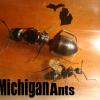About three weeks ago I captured some Tetramorium workers from my backyard and put them in a small formicarium. A few of them have died since then and today I decided to add a few more workers to replenish their numbers. After grabbing some from the same ant hill as the originals and dumping them in, I was surprised to see a mini Tetramorium war erupt. While I can't identify new from old, I'm pretty sure all of the newcomers were killed.
This experience got me wondering how long it takes an ant or group of ants to lose the original colony's scent. While I really have no justification for thinking so, a few weeks just seems like too short a time for them to have evolved their own unique scent. I know Tetramorium are very territorial and this is about the time of year when they start warring with other Tetramorium colonies, so perhaps they're hypersensitive. Anyway, I was curious if anyone has had similar experiences with ants rejecting their former colony.






















